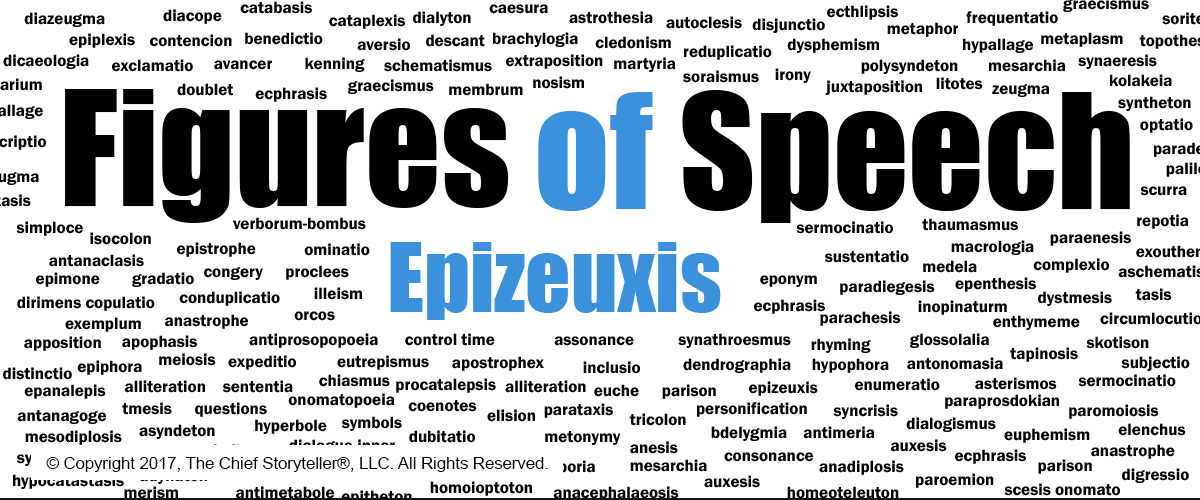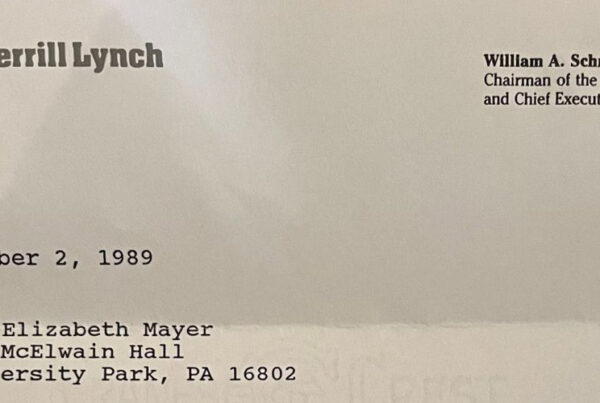
This blog post is about Epizeuxis, a Figure of Amplification. It is part of a series on figures of speech and story elements. I share them as the English language has hundreds of literary devices to help you (dramatically) improve the effectiveness and impact of your various communications.
Repetition used well, strengthens your written and spoken narrative with emphasis and emotion. Repetition is by far, one of the most powerful of all figures of speech. Why? Because as human beings, we are programmed to recognize patterns and to pay attention to them.
While I include background information, Greek word derivation, and pronunciation, what is most important is the application of each figure of speech in your written, spoken, and social media communication.
I tell my consulting customers, workshop participants, coaching clients, and students (I’m an adjunct professor at The Robert H. Smith School of Business at the University of Maryland), the same thing:
“You never have to remember the actual Greek word for the figure of speech. Just remember the concept and application.”
Emphasis & Impact Figures of Speech include Anadiplosis, Anaphora, Asyndeton, Diacope, Epanalepsis, Epiphora, and Polysyndeton.
Amplification Figures of Speech include Auxesis and Epizeuxis,
Figures of Sound include Onomatopoeia.
Other Figures of Speech include Procatalepsis and Portmanteau.
There are three major sections:
- Figure of Speech. Includes a little background, usage, definition, pronunciation, other related figures of speech, and etymology.
- Usage Guidelines. Follow these guidelines to ensure maximum impact.
- Examples of Epizeuxis. Find examples from speeches, presentations, presidential addresses, poems, music, and more
1) EPIZEUXIS – REPETITION FIGURE OF SPEECH
Epizeuxis is a dramatic literary device. Use Epizeuxis to go a little over the top to add artistic effect. Because Epizeuxis stands out in any communication, its effectiveness typically diminishes with repeated use. Use Epizeuxis sparingly. Use it to underscore the importance of your idea.
Use it to really, really, really emphasize an idea, drawing the reader’s or listener’s attention to your words.
| Definition | Epizeuxis is a word or phrase repeated at the beginning of a successive phrase, clause, or sentence, two or more times. It is the emphatic repetition of a word with no other words in between, in just one sentence. |
| Pronunciation | ep – ee – ZOOX – sis |
| Also Known as | cuckowspell, doublet, geminatio, underlay, palilogia |
| Related to | Diacope |
| Etymology | Derived from the Greek word, επίζεύγνυμι, “Fastening Together” |
2) USAGE GUIDELINES
Here is my own definition of Repetition.
Repetition is a literary device where a word or phrase is repeated two or more times to emphasize the point being made and/or emphasize the emotional feeling associated with the point being made. With more than 30 forms of repetition, it is more commonly thought of as a category rather than thought of as a single figure of speech.
Here are some guidelines for you to ensure Epizeuxis, your figure of amplification, achieves your communication goals:
| Use Sparingly | Too much of one type of repetition will likely reduce its effectiveness and may cause your audience to miss your emphasis entirely as there are too many instances of your repetition. As such use Epizeuxis sparingly and for that matter, all of your figures of speech. |
| Choose a Simple Word or Phrase | If you were to analyze narratives where Epizeuxis is used, you would find the authors use simple words and simple phrases. Ensure your audience is able to readily remember your ideas. Simple always wins the day. |
| Repeat 3 Times | With Epizeuxis, three instances are generally better. Practice out loud and determine if two instances sounds better. Vocal variety is very important when using Epizeuxis (see Emphasize with Your Voice directly below). |
| Use Your Orchestra |
In my training and teaching, I share specifics on how to use one’s voice to add (dramatic) impact to your spoken communication. Think of yourself as an orchestra with three main instruments: i) your Words; ii) your Body (Language); and iii) your Voice. Using your orchestra effectively, is what separates a good speaker from a great speaker. A good trainer from a great trainer. A good leader from a great leader. |
3) EXAMPLES OF EPIZEUXIS
Look at the examples below. See how Epizeuxis is used to dramatically increase the effectiveness and impact of your words. Then experiment, mixing and combining other figures of speech in your written, spoken, and social media communication.
Example 1: Winston Churchill’s “Never Given in, Never, Never, Never” Speech, 1941
| Without Notation | In October of 1941, as England was fighting for its life against Germany during World War II, the English Prime Minister, Winston Churchill, delivered a speech meant to galvanize the English people so that they wouldn’t give up in the face of German power. The following lines were part of the speech:
“Never give in — never, never, never, never, in nothing great or small, large or petty, never give in except to convictions of honour and good sense. Never yield to force; never yield to the apparently overwhelming might of the enemy.” |
| With Notation |
“Never give in — { never, never, never, never }, in nothing great or small, large or petty, { never give in } except to convictions of honour and good sense. { Never yield to } force; { never yield to } the apparently overwhelming might of the enemy.”
Note 1: { Never give in } is repeated twice. This is an example of Anaphora. |
Example 2: Oprah Winfrey, Stanford University Commencement Address
| Without Notation | “So, they sent me to a salon where they gave me a perm, and after a few days all my hair fell out and I had to shave my head. And then they really didn’t like the way I looked, ‘cause now I am black and bald and sitting on TV. Not a pretty picture. But even worse than being bald, I really hated, hated, hated being sent to report on other people’s tragedies as a part of my daily duty. Knowing that I was just expected to observe, when everything in my instinct told me that I should be doing something. I should be lending a hand.” |
| With Notation |
“So, they sent me to a salon where they gave me a perm, and after a few days all my hair fell out and I had to shave my head. And then they really didn’t like the way I looked, ‘cause now I am black and bald and sitting on TV. Not a pretty picture. But even worse than being bald, I really { hated, hated, hated } being sent to report on other people’s tragedies as a part of my daily duty. Knowing that I was just expected to observe, when everything in my instinct told me that I should be doing something. I should be lending a hand.” |
Example 3: Harry Weller, General Partner, NEA, Speaking at Event I attended
| Without Notation | “It’s been a year of high highs and low lows.” |
| With Notation |
“It’s been a year of { high highs } and { low lows }.” |
Example 4: Monty Python, “Spam” Comedy Sketch, 1970 (Excerpt)
| Without Notation | Waitress: Shut up! Shut up! Shut up! Bloody Vikings. You can’t have egg, bacon, Spam and sausage without the Spam. Mrs. Bun: I don’t like Spam! Mr. Bun: Shh dear, don’t cause a fuss. I’ll have your Spam. I love it. I’m having Spam, Spam, Spam, Spam, Spam, Spam, Spam, baked beans, Spam, Spam, Spam and Spam. |
| With Notation |
Waitress: { Shut up! Shut up! Shut up! } Bloody vikings. You can’t have egg, bacon, Spam and sausage without the Spam. Mrs. Bun: I don’t like Spam! Mr. Bun: Shh dear, don’t cause a fuss. I’ll have your Spam. I love it. I’m having { Spam, Spam, Spam, Spam, Spam, Spam, Spam }, baked beans, { Spam, Spam, Spam } and Spam. |
Example 5: Elli Goulding Song, Burn (Excerpt)
| Without Notation | And we gonna let it burn burn burn burn We gonna let it burn burn burn burn Gonna let it burn burn burn burn We gonna let it burn burn burn burn We can light it up up up So they can put it out out out |
| With Notation |
And we gonna let it { burn burn burn burn } We gonna let it { burn burn burn burn } Gonna let it { burn burn burn burn } We gonna let it { burn burn burn burn } We can light it { up up up } So they can put it { out out out } |
References: I use a combination of my experience, my personal library of books and journals, sources from the Internet, and my 710-plus page Story Elements Resource Guide. My favorite sources include, in alphabetical order: American Rhetoric, Encyclopedia Britannica, LitCharts, Literary Devices, Merriam-Webster Dictionary, Oxford English Dictionary, Silva Rhetoricae, and ThoughtCo. My favorite books include: A Handbook of Rhetorical Devices by Robert A. Harris; Elements of Eloquence by Mark Forsyth; and A Handlist of Rhetorical Terms, 2nd Edition by Richard A. Lanham.
Updated March 2019
Photography Source: Message Cloud/Word Cloud created by The Chief Storyteller®, LLC. © Copyright 2019. All Rights Reserved.
#chiefstoryteller #communication #figuresofspeech #language #rhetoric



